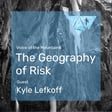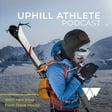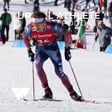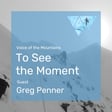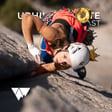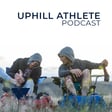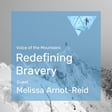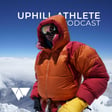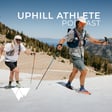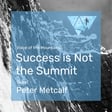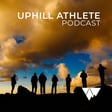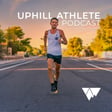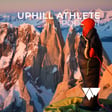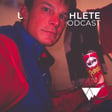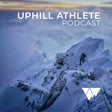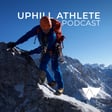Become a Creator today!Start creating today - Share your story with the world!
Start for free
00:00:00
00:00:01

Talking Safety and Preparedness for Backcountry Skiing with Larry Goldie.
Backcountry skiing is experiencing a huge surge in popularity. Scott Johnston discusses the implications, and the issues, with Larry Goldie, an AMGA-IFMGA-Certified Mountain Guide based in the North Cascade Mountains.
Transcript
Introduction to Uphill Athlete Podcast
00:00:01
Speaker
Welcome to the Uphill Athlete Podcast. These programs are just one of several free services we provide to disseminate information about training for mountain sports. If you like what you hear and want more, please check out our website, uphillathlete.com, where you'll find many articles and our extensive video library on all aspects of training for and accomplishing a variety of mountain goals. You'll also find our forum, where you can ask questions of our experts and the community at large.
00:00:30
Speaker
Our email is coach at uphillathlete.com and we'd love to hear from you.
00:00:36
Speaker
Welcome to another episode of the Uphill Athlete podcast.
Meet Larry Goldy: Expert Guide
00:00:39
Speaker
I'm your host, Scott Johnston, co-founder of Uphill Athlete. And today it gives me great pleasure to have one of my truly dear friends on the podcast with me, Larry Goldy. And Larry and I go quite a ways back and have had a lot of interesting adventures in the mountains together. Larry is a fully certified IFMGA guide.
00:01:00
Speaker
He is also one of the lead examiners for the AMGA for guides examination. He's an ARRI, which is an, what is the acronym for ARRI? What does that stand for? ARRI stands for the American Institute of Avalanche Research and Education. Okay, so Larry is a
00:01:23
Speaker
He's a trainer of the instructors for those courses and he also leads all their pro courses. He's been guiding for 25 years. He's also the snow safety director and lead guide for North Cascades heli skiing.
00:01:39
Speaker
And he's co-owner at North Cascades Mountain Guides, and they do a lot of ski touring guiding in the winter as well.
Ski Touring Surge and Its Effects
00:01:47
Speaker
And what I wanted to talk with Larry about is ski touring. And what I have noticed, and I think anybody who's been out in the mountains this winter has noticed this explosion of the number of people who are out there on ski touring gear.
00:02:04
Speaker
I think that's resulted in a lot of changes, certainly in our little area, Larry, I think you'd agree, that has really changed the character of the place. So I wanted to hear from you what you see and what you perceive as some of the positives and the negatives of that. But thanks a lot for joining me.
00:02:26
Speaker
Yeah, it's great to be here, Scott. You know, I'd start out by saying that the explosion in backcountry skiing has really been happening for a number of years now. You know, if you look in the trends within the outdoor industry, sales of backcountry gear has been really
00:02:48
Speaker
you know, on the sharp rise for quite a few years now. And then this year, I think we're seeing an even bigger surge in that largely just because of the situation we're dealing with in the country right now in the world with COVID.
00:03:05
Speaker
So the ski areas are limiting numbers and safest place to be is outside. Everyone's been cooped up for almost a year now. So backcountry skiing is kind of an obvious way for people to get out, recreate with friends. Being on skis just lends itself to social distancing.
00:03:27
Speaker
So you know by default I think we're seeing this giant increase this year in particular. People that have thought about it in the past have decided this is going to be the year. And so not just in our area but throughout the country I hear stories from you know friends that I have in all the different mountainous regions around the country and everyone seeing the same incredible surge in the use of the backcountry.
00:03:58
Speaker
And I would imagine that both North Cascades Mountain Guides and North Cascades Heli Skiing have seen a bump in their business as well, haven't they? Absolutely, yeah. North Cascades Mountain Guides, you know, we also teach recreational avalanche courses. And we historically have limited ourselves to just a couple courses a year.
00:04:22
Speaker
We've taken the approach that there are plenty of avalanche course providers in the Northwest. And we're a little bit off the beaten track here in the Metau. It's hard for people to get here. And by that same token, it's hard for people that are here to go anywhere else. So we've always felt like if people living in the Valley want to take an avalanche course, then we don't want them to have to leave the Valley to do it.
00:04:49
Speaker
but we're not necessarily trying to compete with all the companies based out of Western Washington that really meet the needs of all the people in the Puget Sound region.
00:05:04
Speaker
That said, we have had more requests for avalanche courses this year, largely by locals, but even people from Seattle who we tried to dissuade and say, no, you should take a course on the west side of the mountains. But they still wanted to come here and we run more avalanche courses this year than, you know,
00:05:26
Speaker
any year in the past as well as we've had you know guides working almost every single day of the winter this year which is that's a rarity for us in the past. Heli-ski operation here is also dealing with kind of historic bookings and I think
00:05:48
Speaker
That has a lot to do with people's inability to travel, you know, so many skiers like to go up to Canada, especially
Challenges of Backcountry Skiing
00:05:57
Speaker
for helicopter skiing, you know, there's so many mechanized operations up there. And with us not being able to cross the border into Canada, now all those people are locked into the
00:06:12
Speaker
the US south of the border and are looking for heli operations here. So our phone there has been ringing off the hook as well. It's a good problem to have, I suppose, as a business owner. It's not a bad position to find yourself in.
00:06:27
Speaker
It's not, although we also we want to be responsible and respectful of the fact that it is getting more crowded out there. And so at NCMG, the company where I take part in some of the management decisions, we have limited the number of guided guests that we'll have out in the field on any given day, just so
00:06:55
Speaker
So we're not sort of overburdening the resource in the back country just by taking too many people out there. It's a good problem to have but to some degree it still is a problem because more and more people are out there. Thank goodness this year we've been in this La Nina pattern where we've been getting pretty regular snowfalls and
00:07:24
Speaker
When it snows frequently enough that everything keeps getting refreshed, then you don't have this issue of scarcity where everybody's competing for the same untracked slopes. When it snows every few days, those same untracked slopes remain untracked and everybody can find what they're looking for every day.
00:07:48
Speaker
What are some of the downsides that you see both currently and potentially in the future with this increased usage that we're seeing?
00:08:01
Speaker
Well, you know, one of the things that we're seeing this year, even though on the one hand, I just said so many people are taking avalanche courses, we're still seeing a lot of people out there who, you know, to be perfectly honest, I have no idea whether or not they've taken an avalanche course, but clearly by the decisions they're making, they're quite inexperienced. And, you know,
00:08:28
Speaker
aren't always making the best decisions. You know, in general, it's harder to trigger an avalanche than, you know, we're sometimes led to believe. And in general, especially here in the northwest, we have a pretty benevolent snowpack. So it's easy for people to get lucky and think that they're actually making pretty good decisions when in fact they're making poor decisions, but they're getting lucky. And so
00:08:57
Speaker
you know, already this year, I've seen that more than a few times of people doing things they really shouldn't be doing on certain days, but they're getting lucky and they're being rewarded, you know, because they're not getting feedback that that was a poor decision, at least from the snowpack, and they might get it from me. More often than not, I generally don't, you know, offer unsolicited advice like that, but I have been seeing that out there.
00:09:27
Speaker
We're just seeing a lot of people and, you know, it should be said, a lot of these people are quite skilled when it comes to skiing or riding, you know, they have a high level of movement skills, but their avalanche understanding and their, uh, their ability to use the terrain appropriately doesn't really match the skill they have of being able to ride the terrain.
00:09:55
Speaker
I've seen the same thing, so I'd agree with you. I know it's one of your pet peeves. Certainly one of mine are these terrible up tracks that get set by those people that don't have much experience in the mountains and don't really know how to use the terrain either from a safety standpoint or just a convenience standpoint.
00:10:14
Speaker
Yes. You know, in fact, I'm glad you bring that up because that is something that whenever I'm teaching an avalanche course, you know, which has quite a bit of overlap, especially the early level avalanche courses tend to be people that are just getting into ski touring. So there's a lot of overlap with kind of an intro to back country skiing course. Uh,
00:10:40
Speaker
And I really encourage people during these courses if they don't like the up track they're on to just abandon it and make their own up track. So it's a common thing. People think, oh, it's so much work to break trail. And so they just follow any trail that's out there. And some of the trails that are out there, as you just described, are just horrible.
00:11:05
Speaker
and they don't often use the terrain the way they should. And what most people don't realize is that even if it is a little more work to break trail, in the end, the efficiency you gain from putting in an appropriate trail is often rewarded in the energy you save by not following a steep track that has a lot of kick turns.
00:11:34
Speaker
So it's usually going to be worth the effort. That has certainly been my experience. There's this sense that I'm in a hurry. I want to get to up as fast as I can. And while it can work for the first few people over that track, but once the track gets skied in a bit and gets a little glazed, then people's skin stop grabbing. And it can be a lot of work to get up there.
00:11:59
Speaker
Is the main thing you've seen the steepness or just also like poor terrain selection in the club track? Yeah, you know, I would say it's a combination.
00:12:11
Speaker
I remember the very first time I had the epiphany that we're talking about right now. I was out skiing with a few friends, this is 20 years ago now, and it's deep trail breaking and a local skier catches up to us, somebody we knew, but
00:12:30
Speaker
guy we didn't ski with a lot and he you know the guy was an incredibly fit athlete and he caught right up to us and then he offered to take a turn breaking trail and when we put him out front he immediately flips up his risers and starts going steeply up the hill
00:12:48
Speaker
And what started out as this enjoyable tour, suddenly, you know, we're all sweating or all fighting, not slipping backwards on the trail. And, you know, nobody's talking anymore. And finally, after like 30 minutes of this, we just decide, you know what, let's just go back to making our own trails. It's ridiculous.
00:13:11
Speaker
And this guy too, his credit had just like dropped all of us, even though he was breaking trail, we couldn't even keep up with him. And so we start breaking our own trail and now we're telling stories and laughing and having a great day again. And lo and behold, by the time we got to the top, we caught him.
00:13:30
Speaker
And that was when I had the epiphany of like, oh my gosh, you know, it's only quicker if you are climbing a short slope. If you are in it for the long haul, the low angle efficient track is going to be the way to go.
00:13:45
Speaker
And what I've noticed recently as the backcountry gets busier, what I think a lot of people don't realize is that up tracks tend to have quite a long lifespan. So in other words, if I put in a track going into first bowl,
00:14:06
Speaker
Then, you know, it might snow four or five inches and then somebody goes in there tomorrow and they say, Oh, here's an old track. And they re-break the track. And then people start using that track for a few days. And now it's getting really beaten in. And then it snows another 10 inches and people go up there. It's like, Oh, they sniff out. Here's an old up track. And so a track that gets put in can sometimes last for weeks and weeks and weeks. And so the rule of thumb,
00:14:36
Speaker
you
00:14:36
Speaker
that we try to encourage people is that the up track should always utilize the safest terrain available regardless of what the avalanche hazard is. You know, you can think about you have the most vulnerability when you're on the up track, right? Your group is generally close together. People are stripped down to their lightest layers. Everyone that has tech bindings has their toes locked in into the ski. So
00:15:06
Speaker
If you are exposed to an avalanche, your group is in a really vulnerable position. So we address vulnerability by choosing the safest terrain available. So even on a low hazard day, I'm going to put my track in the safest available terrain. And that way, if my track has a lifespan of three weeks and two weeks later, now it's a considerable hazard, that up track should still be
00:15:36
Speaker
a good option for folks. And if I put in a nice low angle track, then even after people skinning on it for several weeks, it's not gonna be too steep or too slippery, and thus it can have a good long lifespan. And I would say the vast minority of up tracks out there that I'm seeing fall into that category.
00:16:03
Speaker
Yeah, I know that you and I used to grouse about that lots of fun. We'd be out skiing and saying, who the hell put this track? And we, as you call it, we would edit the track, edit the up track. And it doesn't take very long for
00:16:21
Speaker
people to catch on to that idea. But I just think with this, like, I would say 10 or 15 years ago, the relatively small group of people that skied here at that time, which probably could have been under a couple of dozen, I'm sure, were pretty well educated on that fact. But with this rise of popularity and these new people coming in that don't have that experience,
00:16:48
Speaker
they're like you said, not only do they not know that epiphany that you had, but they also don't know how to read mountain terrain. Like you said, they got very high downhill skiing abilities, but not necessarily a lot of mountain experience and certainly mountain experience in avalanche terrain. Yeah, I would agree. Yeah.
00:17:11
Speaker
Oh, and I think that, that lesson about the uptrack, uh, it's something I actually learned from Steve years ago. Steve house. This is Steve house. Yeah. So Steve used to be the training director here at NCMG, my company. And, uh, I remember, you know, years ago when he was helping prep me for one of my ski exams and he told me, uh,
00:17:39
Speaker
I use this line all the time and I do give him credit, so in case he's listening. He says, when your clients show up in the morning, they come with a certain amount of energy to spend for the day. And as a guide, it's your job to budget that energy. And so as a ski guide, the way you budget that energy is largely with the track you set.
00:18:05
Speaker
And so I have countless days under my belt where I have, I've been able to like test this hypothesis of going into an area where there was an uptrack and we used an existing uptrack compared to a day where I put in a really good uptrack with the same guests. And I could see, I could get so much more skiing out of those people when they were following the easier, lower angle, more moderate.
00:18:35
Speaker
it up track. And I think some people, especially people that are just getting into the sport, they really, you know, they enjoy the athletic challenge of going uphill. And they look at it as kind of a workout, I like to go as steep as I can. Because, you know, I really want to work hard. And I always tell people, you can still put in a good up track, just go faster, you don't have to go steeper.
00:19:03
Speaker
So, but yeah, I am such a strong believer that it's so much more efficient to use a lower angle up track and it'll just get you more skiing at the end of the day.
Learning Skiing Skills for Safety
00:19:19
Speaker
And for this newer audience that's coming into ski touring these days, other than a basic avalanche course that will hopefully, if the instructors are good, give them some ideas on how to set an up track and how to choose the appropriate terrain, are there any kind of beginner ski touring courses out there that you know of?
00:19:43
Speaker
Yeah, you know, a lot of guide services nowadays are offering introduction to backcountry ski courses.
00:19:51
Speaker
And while some of this stuff does get touched on in an avalanche course, there's so much in the curriculum of a three-day level one avalanche course already that it can be really challenging to go too far into general back country touring skills. And it's one of the issues that we see sometimes people think, I want to get into back country skiing. So the first thing I need to do is take an avalanche course.
00:20:20
Speaker
When I would argue the first thing you need to do is learn how to ski Because we do see plenty of people that you know Because their ultimate goal is to backcountry ski. They feel like they need to take an avalanche course first They can easily grasp this the concepts of an avalanche course But then they literally cannot ski downhill
00:20:46
Speaker
So first step, learn how to ski. And let me stop you there for a second.
00:20:52
Speaker
What, you and I both know that maybe learning to ski in the back country is not the best way to do it because you just don't get that much downhill. You know, for all the time you're going to spend slogging uphill, you don't get to go down. So do you recommend that people go to downhill ski areas to do this? Absolutely, yes. That is by far and away the best place to learn the skiing skills.
00:21:20
Speaker
You know, if people don't really come from much of a ski background, I encourage people to buy a season pass at a ski hill and try to commit to getting, you know, 30, 50 days in over the course of a year. And I know it's a lot for a lot of people, but the thing with skiing is what it comes down to is it takes mileage and it takes enough repetition to create the muscle memory.
00:21:47
Speaker
because as you're skiing down you've got the snow changing under your boots every couple turns and the terrain is constantly variable and your body is moving through space and sometimes you have a backpack on and so you can't think quickly enough to make all these micro adjustments your body just has to learn how to do it and it takes a lot of repetition and as you just alluded to
00:22:14
Speaker
you just cannot get that volume of repetition in the back country. An average day of back country skiing, I would say most people are gonna ski between three and five or 6,000 feet.
00:22:30
Speaker
vertical feet and you know at a lot of ski areas that's one or two runs you know you can do 10 sometimes 20 runs a day at a ski area with high speed lifts so you realize like you're just going to get so much more time spent working on the downhill portion at a ski area
00:22:54
Speaker
And I would encourage people that are just getting into the sport as well to start out with some lessons. Like the earlier you start with ski lessons, so you're building a really strong foundation, the quicker you're gonna develop as a skier. Ski is one of those things that if you teach yourself how to do it, your body is gonna develop all these kind of bad habits and
00:23:21
Speaker
sort of workarounds for inefficiencies in your movement. And then hiring an instructor to get you to unlearn those things and reprogram your movement patterns is going to be way harder than investing a little bit of money at the beginning to getting a strong foundation.
00:23:42
Speaker
I think that's the case with any high-skilled sport. Getting good instruction just speeds up the learning curve so much that then you can go out in the backcountry and enjoy yourself instead of going out there and falling with every turn and wondering why you can't do this. Do I really suck that much as a skier?
00:24:04
Speaker
I'm glad that we can talk about these things because I know that you have spent a considerable amount of time and even some time with some of the uphill athletes that we have going skiing, taking them skiing, and in some cases finding out that, oh, let's just go to the local ski resort and do a few laps there. Then tomorrow we'll go into the back country. And I can see that that has been really beneficial.
00:24:33
Speaker
Yeah, there's really no substitute for the kind of mileage you can get at a downhill ski area. And over the years, I've spent at least eight or 10 seasons working full time at ski areas. And when I look back at how much my skiing has progressed each of those years, and then it's pretty easy to take those skills
00:25:03
Speaker
and transfer them to the back country because ultimately the movement patterns are the same whether you're skiing, you know, in knee deep powder or on perfect corduroy. It's just a slight different blending of the movement skills that you're using depending on the snow conditions. But, you know, the bulk of the movement patterns are the same.
00:25:30
Speaker
And what's interesting, one thing that came to my mind when you just mentioned that speeding up the learning curve is now I have a young daughter and she's been on skis since she was two years old and she's been in lessons basically since that age or essentially from time she was three.
00:25:52
Speaker
and she's eight years old now and my wife can barely keep up with her and she's a good skier and the kid you watch this kid flying down the ski hill and she has perfect ski form because she never learned any bad habits.
00:26:10
Speaker
And it's amazing to see how just those lessons at an early stage of her learning process has just transferred into this incredibly efficient movement patterns. And now, when I take her to the ski hill, all she wants to do is ski the most challenging runs, and she wants to go off in the untracked snow, and she can just do that all day long.
00:26:37
Speaker
It's pretty fun. It is. Before too long, you won't be able to keep up with her. I know. That's one of the beauties of learning these things as a child because your nervous system is so much more plastic at those ages and you just get those skills and greatest like the old adage about learning to ride a bicycle.
00:26:58
Speaker
And then never being never not mean she's gonna know how to ski her entire even if she didn't ski for the next 20 years She will know how to ski for the rest of her life. And that's that's a cool thing Let's talk about equipment a little bit because you know, I know there's been a big
Avalanche Safety Tools Discussion
00:27:18
Speaker
push in the last, probably you know better, but 15 years or so to avalanche packs that contain inflatable devices for avalanches. I want to hear your opinion on them, and I want to know if you think that those give people a false sense of security.
00:27:41
Speaker
Yeah, that's an interesting question. So full disclosure, I use an Avalanche airbag pack and I probably have pretty consistently for 10 years now. The way I look at it is it's another tool. It's another layer of protection. So I would guess a lot of your
00:28:09
Speaker
listeners are familiar with this idea of reasons model or sort of the Swiss cheese model. I know it's been talked about a lot with COVID as like, you know, you want to give yourself all these layers of protection about something and each layer is like a piece of Swiss cheese. And when you put all the pieces of Swiss cheese together, you're hoping that none of the holes line up so that something can go all the way through. And so,
00:28:36
Speaker
That's the way I look at the airbag pack is it's just another layer of protection. So I'm not going to let it affect my decision making. I'm not going to ski a run because I have an airbag pack. I'm going to go through the same process in the morning of
00:28:53
Speaker
you know, looking at the weather, looking at the avalanche forecast, knowing what's going on with the snowpack, going to look at who's in my group for the day, and then based on those factors, I'm going to choose some terrain that's appropriate given all those considerations. Once we get out into that terrain, you know, we'll further make assessments of where exactly we want to ski
00:29:22
Speaker
But no matter how confident we are, we're generally always dealing with some amount of uncertainty. And so the way we manage uncertainty in the backcountry is by building some margins into our terrain. So the more uncertainty we have, the more margin we want to give ourselves.
00:29:45
Speaker
but there's always a chance at some point and many, many experts before me have proven that you're gonna get it wrong sometimes. You're gonna make a mistake and you wanna make sure that the consequences of that mistake don't necessarily cost you dearly. And so I look at that airbag pack as
00:30:11
Speaker
I'm going to do everything to the best of my ability, but then still, if I screw up, or if I'm wrong, or I underestimated something, and I do get caught in an avalanche, I want to give myself one more chance of not getting buried.
00:30:30
Speaker
by having that pack and they're not foolproof right so you know they're not gonna protect you from getting smacked into a tree or they're not even gonna keep you from getting buried every single time but they're just gonna make the likelihood that you'll come out on top much much higher.
00:30:51
Speaker
So that all essentially has to be weighed against the cost of the pack. They're not that cheap. 800, some of them are close to $1,500. And then you're looking at an extra four to five pounds in an empty pack. So no matter how much you're carrying, it's going to be four or five pounds heavier. And that's where the technology is getting better. They're getting lighter and lighter.
00:31:20
Speaker
But you're still going to be looking at at least a few pounds heavier than a typical ski touring pack. And so for me, when I do the math on that, you know, I would rather do a few more squats and just get in a little bit better shape and carry the extra weight for that ability to increase my likelihood of not getting buried. And fully concur with everything you've said, I think
00:31:49
Speaker
But you're in a position as a professional and with many, many years of experience doing this where you can view that pack as, and I'm not trying to be contentious here. I don't really even have a strong opinion on this, but.
00:32:03
Speaker
But what you just explained to me, which completely makes sense, is that you're viewing as just another tool, and it gives you a slight, a little bit bigger safety margin. But I'm just wondering if the people who aren't as educated as you are don't have the experience that you have, maybe a little more cavalier with that approach. And I suppose,
00:32:29
Speaker
that could vary a lot from person to person. But I can just sort of see that kind of thing happening. It's like, oh, and especially people who haven't actually seen the consequences of an avalanche before that say, oh, well, fine, I've got this airbag. I'll be able to ride it out or whatever. So anyway, that's just a thought I had. I don't really know how would I come down on it.
00:32:52
Speaker
Yeah, there is something to that the concept of risk homeostasis they say you know With things like seatbelts and airbags and cars You know people have generally While they have saved lives over the years people have also engaged in riskier behavior And so they've offset some of the potential benefits of some of those safety devices so
00:33:20
Speaker
I do think there's certain population that, yeah, is more likely to engage in the kind of decision-making of, well, you know, I wouldn't normally ski this slope, but I have my airbag, so I think it'll be fine. And I'm not sure, you know, really how, what's gonna change that sort of thought process. Ultimately, I would say, you know,
00:33:48
Speaker
based on what you just described. I have been doing this for a long time and I still, I understand the uncertainty that even people like me and people far smarter than me still deal with all the time. The snowpack is just so variable over terrain that we're always dealing with a certain level of uncertainty.
00:34:16
Speaker
And so the people who don't even know how high their uncertainty is there, the people that should have these packs more than anyone else, because they're far more likely to make those mistakes.
00:34:28
Speaker
You know, in my mind, Scott, as the technology improves and as these packs get lighter, and over time, though, will become less expensive, but my guess is that there'll be a point where the vast majority of the people will be wearing these packs. So it'll be sort of like Beacon Shovel Probe airbag pack.
00:34:53
Speaker
We're starting to almost see that with helmets in the back country now. I'd say it's got to be close to 50%. And I would say it's somewhat geographic, certain areas. I bet it's far more than 50% of the people are wearing helmets. But over the years, I've seen a dramatic increase in the use of helmets in the back country as well. I don't get out as much as you do.
00:35:22
Speaker
And I haven't been really active in the back country for a few years now. But when I am out there, I see helmets all the time now. Whereas 10 years ago, you just almost never saw anyone with a helmet. That is an interesting evolution.
00:35:37
Speaker
Well, I think the packs are a wonderful thing. I own one like you, and I appreciate that it could be a lifesaving tool. I just was curious in your thoughts on that subject, whether you thought it might lead to riskier behavior, but we can leave that. I don't need a definitive answer. What about, you know, one of the things that I think you and I, when we used to ski together almost daily for many years,
Dressing for Cold Weather Efficiency
00:36:06
Speaker
and would see is people dressed really inappropriately for the activity. So give us your thumbnail sketch of what's good attire and not such good attire for this kind of sport. Yeah. So one of my cardinal rules that I tell people that I ski tour with all the time is that you're not allowed to break a sweat
00:36:35
Speaker
in the backcountry unless you're down to your lightest layer of clothing. So if you think about it, we're out in the middle of winter. It's usually well below freezing out. We are exercising, yes, but there's really no reason to be sweating in those cold temps unless we're overdressed.
00:36:57
Speaker
So I see the same thing all the time. People, you know, there's this misconception about Gore-Tex, for example, that it's breathable and so you can sweat and somehow you're gonna still miraculously stay dry. And I often tell people that Gore-Tex breathes far better when it's in the bottom of your backpack than when it's on your body. But ultimately, what I think people need to do is just get in that mindset of,
00:37:28
Speaker
I can't sweat out here, so I'm gonna adjust my temperature with my clothing, and it's not a big deal. I don't like to be cold, so I'm not one of those people that say, be bold, start cold. I start with all my clothes on, but I get five minutes up the trail, and I stop, and I drop my pack, and I peel off all my layers till I'm at a, you know, dressed appropriately, and that stop typically takes me about 30 seconds.
00:37:58
Speaker
And I will make up that 30 seconds really in probably the next five minutes of skinning when I'm dressed appropriately for the weather. So I just really encourage people like it's not a big deal to just stop and change your layers while you're moving. And if you're out with a group, you don't even need to stop the whole group. You just step out of the up track
00:38:23
Speaker
adjust your layers as you need to and then you know step back into the track and keep going. And one of the easiest ways to adjust layers is often with your on your head and on your hands. So you know most of the time when I'm skiing I'll have like a wool ski hat on and one of the first things I do when I get warm is I just take that hat off and I'll shove it in a pocket.
00:38:50
Speaker
And you can dump a lot of heat out through your head. And if I'm still really warm, I'll often take my gloves and clip them onto a carabiner and clip it onto the waste belt of my pack. So I have them right there. And so those are some micro adjustments I can make without having to stop.
00:39:08
Speaker
But if I'm generally dressed correctly, but I still wanna add or subtract a little heat, I'll often do that with gloves and a hat.
00:39:21
Speaker
And then whenever we stop to take a break, typically the very first thing I do is throw some clothes back on. So you've just worked hard to build up all this warmth. So you want to capture that warmth. So as soon as I stop for a transition or a break, get some food while we're skiing.
00:39:41
Speaker
First thing I'll do is put on a big puffy jacket and I'll keep that on the whole time we're at a break. And the very last thing I'll do before we start skinning again is take it off and shove it in my pack. So ultimately it just, once again, it comes down to efficiency. I'm trying to keep my body in its optimal operating temperature all day. So I don't want to be too hot or too cold.
00:40:07
Speaker
And do you prefer for that big puffy jacket to be synthetic or down?
00:40:17
Speaker
I don't have a strong preference there. I would say when the temps are really cold, down is a great layer because it tends to be incredibly warm and it packs down even smaller than a synthetic jacket. But anytime the temps are anywhere near the freezing level or just tends to be like a really stormy, wet day where wetness might be an issue, the synthetic's gonna do a lot better in those conditions.
00:40:46
Speaker
So I use both. I would say I tend to use the down when it's really considerably colder and I use synthetics when it's, you know, closer to freezing.
00:41:00
Speaker
Do you carry more than one pair of gloves for the day? I do. Yeah. So I have a little, what I think of as kind of my emergency kit at the bottom of my backpack, and I keep an extra warm hat and I keep a pair of warm gloves. And those live in my pack for most of the time. It's rare that I tap into them, but
00:41:25
Speaker
You know so much of what we do outside even when we're skiing involves our hands just our ability to You know take our skins on and off our skis utilize our poles Like you just you can't lose your hands So if your hands get really cold and wet you want to have a warm pair of gloves to put them into And then the same thing with that wool hat like if it's really snowing hard uh, or you know if uh
00:41:54
Speaker
let's say the positive side, I'm getting lots of face shots that day and snow just billowing over my head all day. And my hat gets completely soaked. I want to be able to put on something warm and dry on my head. So that's something I'll typically always have is an extra hat and extra pair of warm gloves. And I know you're a big fan of like for your outer layer of soft shell type of clothing rather than a harder shell.
00:42:24
Speaker
And so if you want to talk a little bit, I mean, I guess you've already touched on that with the fact that Gore-Tex belongs in your pack until you desperately need it.
00:42:34
Speaker
because it doesn't breathe, as we know. I mean, even some of the soft shell thing, fabrics don't breathe particularly well. But it certainly, that's something I've seen a lot in the mountains where people were skinning uphill with a Gore-Tex jacket and Gore-Tex pants on and just sweating like all get out. Yeah. You know, I think one of the things, as people are getting more and more into back country skiing,
00:43:04
Speaker
The thing to strive for is to develop systems in really everything you do. So you develop a system for packing, for your layering, for how you do your transitions, even how you dry your gear when you get home.
00:43:21
Speaker
And probably one of the most important things for just being comfortable out there is a good layering system. So, you know, I generally am a big fan of soft shell gear.
00:43:35
Speaker
uh that said though i've found as i've gotten older and i start to run my body just runs a little bit colder all the time i find when the temps are colder that i've been touring in hard shell pants more just because in my soft shell pants i just you know i was having to adjust and wear so many clothes on my upper body that it just felt a little cumbersome and when i put uh
00:44:02
Speaker
hard shell pants on the bottom, it made layering in my upper body easier. So, you know, I still, I utilize both. When it's really cold, I'll often tour in hard shell pants. If it's a little bit warmer, or if I know I'm going to be working really hard, like breaking trail and it's deep snow, I'll often wear soft shell pants.
00:44:27
Speaker
And then I typically, you know, like everything we do in the mountains, we dress in layers. And what I found a good layering system for me is a really lightweight base layer, followed by a really super thin and breathable windbreaker of some kind.
00:44:46
Speaker
And then over that I'll have like a mid-weight layer and then a shell and then finally a big puffy. And I can put those on and take them off in that order that I just described.
00:45:03
Speaker
And many days I find I never make it down below that windbreaker layer. And it's really nice to have a bit of a windbreaker on when we're out in the mountains, unless it's a really warm day. There's typically always some kind of air movement or it's, you know, snowing somewhat. And so I don't want to get my base layer soaking wet. And so having that windbreaker right over my lightest layer of clothing just
00:45:30
Speaker
often keeps me right in that sweet spot of being still very breathable, but shedding some wind and some of the precip that might fall on me.
00:45:44
Speaker
Interesting, great. Well, that's been really helpful. I want to be respectful of your time. I know it's closing in on dinner time and you've got a young daughter you need to attend to. So, but before we wrap up, are there some things that I've overlooked that you would like to talk about? Yeah, you know, I guess
00:46:09
Speaker
There's a couple things to think about. You know, people often ask me why my pack is so heavy. And while I'm not encouraging people to carry heavy packs out there, I do think people should think about a number of things that you want to make sure you have within your group whenever you're out there skiing. So one of the first ones is obviously the first aid kit.
00:46:37
Speaker
And you know that we put this huge emphasis on people taking avalanche classes when in fact If you successfully rescue someone from an avalanche, there is a really good chance They are going to be at the best case scenario hypothermic worst case scenario severely injured and so
00:47:01
Speaker
Having some first aid skills should be on everyone's mind as well.
Essential Backcountry Gear and Skills
00:47:07
Speaker
So if you're spending a lot of time in the winter back country and you feel like you've checked the box by taking your avalanche course, you should also really think about making sure that you've taken some kind of first aid course, wilderness first aid or wilderness first responder. Those are the kind of courses that are going to give you skills to deal with something that goes wrong in the back country.
00:47:30
Speaker
and then give you the ability to actually use the first aid kit that somebody in your group should be carrying.
00:47:38
Speaker
The other thing that I've used far more times than I've used my first aid kit over the years is my repair kit. And so, you know, carrying a small supply of tools and items that you could fix broken bindings, broken ski poles, you know, broken skins, those can save the day out there.
00:48:07
Speaker
And I think probably one of the best bangs for the buck is the humble Volley strap. If people asked me if there was just one piece of gear that I could carry to like MacGyver, almost anything that could break in the backcountry, it would be a Volley strap. I've literally strapped somebody's boot onto a broken binding and had them ski 3,000 vertical feet down
00:48:35
Speaker
uh you know rugged mountainous terrain and they said they could hardly tell the binding was broken i've used them to repair uh you know broken straps or buckles on boots i've used them to strap skins on that stopped sticking or somebody lost a tip clip or a tail clip
00:48:58
Speaker
Uh You can use them to lash skis on your pack. I mean you can use them to build a splint I mean they're just it goes on and on and on so everyone should carry a couple of ole straps in their backpack Kind of like the back country duct tape Yes, basically it is Yeah That's a great call. What about a rescue sled? Do you think that's something that's important to have in a group? Uh
00:49:29
Speaker
That's a good question. You know, it's something I generally always carry when I'm guiding. But, you know, and gosh, over 20 years of doing this, I've never had to put somebody in it. So I don't think it's something that... Wait a minute. I remember you pulling me down with some guides practice a few times where I had to be in the sled. Okay.
00:49:53
Speaker
Fair enough. I wasn't hurt extensively. Yes. But I've never had to actually put a patient in one.
00:50:04
Speaker
So I don't think it's something that every backcountry skier, every group necessarily needs to carry. You know, it's not a bad idea for a group to consider having some kind of, you know, bivisac or a tarp, something in the worst case scenario, if somebody was really injured, you could at least drag them out of the mountains.
00:50:28
Speaker
or just the ability to MacGyver a sled together out of skis and poles. And there again, bolle straps are going to be the key to doing that. There are many tutorials online you can find for rigging something together. It's certainly not going to be as functional as, you know, a back country rescue sled that's manufactured, but, you know, in the worst case scenario, you could get somebody out on that.
00:50:58
Speaker
That does sort of bring up the idea of, you know, when things go terribly wrong out there, just having some ability to communicate with the outside world. So around here, our mountains, we don't have any kind of cell service whatsoever. I know there are plenty of mountainous areas around the country that are in that same situation.
00:51:21
Speaker
And so people should be thinking about, uh, you know, some sort of satellite communication device nowadays, you know, the in reaches and spot devices have become pretty affordable, especially if you sign up for just, you know, the basic emergency plan. So you're only planning to use this if things really go wrong. Uh,
00:51:46
Speaker
You know, it's really cheap insurance, because like I just mentioned, if somebody in your party does get caught in an avalanche, even if you successfully rescue them, that could just be the very start of your problems. Yeah. Well, that's great advice, I think, and good cautionary tale. Certainly, I agree with you completely on the whole satellite
00:52:13
Speaker
communication device if you don't have access to some kind of a radio that will do the same kind of thing, keep you in communication with somebody out of the back country.
Communication Tools for Safety
00:52:23
Speaker
But yeah, and it's nice that those devices now exist and are quite affordable. So if a person can afford the thousands of dollars it costs to outfit them for a real back country skiing, they can certainly afford a couple hundred dollars or whatever those things are to that sort of insurance policy.
00:52:44
Speaker
Yeah, and hearing you mention radio Scott, you know, I just want to put in a quick plug there. It's something that's becoming much more common nowadays is user groups utilizing backcountry radios. They generally work on the
00:53:05
Speaker
the family band channels so you know historically we referred to those as like talk about radios the ones initially made popular by Motorola nowadays BCA makes some called the BC Lynx and they've gotten quite powerful you know they're two watt radio so they they transmit over quite a distance and have a ton of different channels and
00:53:33
Speaker
they are incredibly effective at allowing your group to communicate even when you're essentially out of visual or certainly out of voice range. So, you know, one of the things
00:53:50
Speaker
that we do to stay safe in the back country as we often spread out or we only expose one person at a time to skiing an avalanche path and when we do that one of the downsides is we lose some of our ability to communicate so when we have radios we can maintain that communication while we get the group a little more spread out and so we're seeing that more and more i've been using radios when i guide for years but
00:54:20
Speaker
We're seeing general back country skiers using those all the time now. And I just feel like they're such an incredible tool. They're both helpful in that somebody can ski down and then relay back information about, hey, I just saw some cracking when I skied that run. I'd advise you to take a safer route down.
00:54:45
Speaker
or it could just be hey go even further right than where I went there's a beautiful line through the trees you can use them to steer people into uh you know really nice terrain they're super helpful if you're trying to set up photographs you can get down there get all ready and then call people down tell them where you want them to go so they just have a myriad of uses and uh and certainly safety being one of them
00:55:15
Speaker
Some areas are even starting to designate some, you know, popular back country skiing zones like the Wasatch and parts of Colorado, even Snoqualmie Pass here in Washington where they're designating a standard channel
00:55:33
Speaker
for all ski tours in that area. So if you're getting ready to drop in to say, you know, a popular cougar and you're not sure if there are people in there below you, you could get on the designated channel for your region and say, hey, you know, this is Larry, we're getting ready to drop into the slop cougar. Are there any other skiers down there below me?
00:55:58
Speaker
And if there are other skiers on that channel, they could say, yeah, we're in there right now. Give us 10 minutes and we'll relay when we're clear at the bottom. So that's becoming a much more common thing. That's a great thing. Yeah, that's wonderful to see. I'm familiar with those talk abouts, but they weren't the greatest. So I'm glad to hear they've been improved.
00:56:25
Speaker
Well, Larry, thanks very much for taking the time this afternoon to have this chat with me. I really appreciate it. Yeah, absolutely. People want to get a hold of you, Larry. They can do it through North Cascades Mountain Guides. That's probably the easiest way, right? What's your email there? Yeah.
00:56:41
Speaker
Yep, that is the easiest way to get ahold of email is through there, Larry at nzmountainguides.com. Great. Okay, good. Well, thanks again. I really appreciate it. Yeah, and again. Thanks for joining us today. For more information about what we do, please go to our website, uphillathlete.com.
